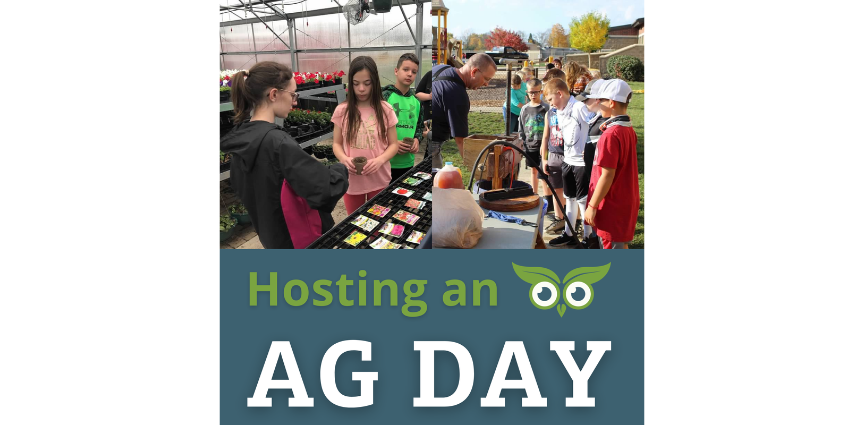
If you are anything like me, I always got super ANXIOUS when I had other teachers or administrators who attended our FFA events.
I always felt like my students were a representation of my teaching and advising ability!
Will students say the right thing?
Will everything go as originally planned?
Will my “squirrelly” students act out?
The imposter syndrome ran deep during these events!
One of these events was always our annual AG DAY we hosted for the fifth graders at our school.
So many many elementary students. So many moving parts. So many items I had to rely on my high school students to complete.
Now I would be lying if the first couple times we conducted this event there were not hiccups, but we learned a lot and it always ended with the elementary students and teachers having a great day!
Here are some of the things I learned throughout the evolution of our Elementary Ag Day:
COMMUNICATE EARLY AND FREQUENTLY
In the fall, my committee chair and I met with the elementary principal and fifth grade teachers to determine a date. The spring can get so busy with assemblies, field trips and testing. By meeting with them early, we were able to set this date aside.
The committee chair would send out progress, schedules and important information to these individuals frequently so this line of communication was strong from start to finish.
SIMPLIFY THE SCHEDULE
We hosted this event during the school day and at our school. This eliminated transportation and finding a location to host. We started the event at 9:00am and ended at 11:00am. There were three fifth grade classes and we broke each class into two groups. We had six locations that groups rotated between: (1) my classroom, (2) my shop, (3) the loading dock behind my shop, (4) the greenhouse, (5) the gym and (6) the parking lot. Each lesson was approximately 20 minutes long.
This meant the only teacher who was displaced from their classroom was the elementary PE teacher and she had 5th graders during this timeframe so it was less of a burden.
Any time I conducted an event, we tried to inconvenience others in our district as little as possible. This structure also allowed the event to go on even if the weather was poor. If rain was expected, we would set up a tent outside for the group in the parking lot.
Here is a Sample Ag Day Schedule.
In the closing session, the committee chairs would ask the elementary students for their favorite part of the day and allow students to ask additional questions. This would also be an opportunity for the chair to encourage students to enroll in agriculture education and join FFA in the future.
FFA members would then ask for elementary student volunteers to do an Agriculture Relay Race where students would have to take turns running back and forth across the gym to put on agricultural clothing/equipment (i.e. welding helmet, safety glasses, flannel shirt, overalls, boots, work gloves, etc.). The winners of this relay would get a free FFA shirt.
CREATE HANDS-ON LESSON PLANS
Just like your agriculture students enjoy hands-on lessons, so do elementary students! I had juniors and seniors in my agricultural business class and they would complete a mini lesson planning unit each year leading up to our Ag Day. The planning and presentation skills aligned with the business standards and it made creating lesson plans for the event more streamline.
The topics varied from year-to-year but I always saved the lesson plans so students would have a starting point if they wanted to reuse a topic. Here are some of our favorites:
Dairy Industry Evolution Lesson Plan
As you can see, all of the lessons had some hands-on component and often had the students demonstrating or making something. This made presenting easier for the FFA members and allowed them to reach the 20 minute mark.
Many of the lessons also involved food. It is important to ask teachers for a list of students with allergies or intolerances prior to the event.
COMPILE FFA VOLUNTEER LIST
Over the years, we found that it was beneficial to have three student volunteers to teach each lesson. I tried to have students who were in the same agriculture class teach together so I could give them time to read the lesson plan together and make a plan for who was presenting which portion of the lesson.
We also had one student assigned to each group so they could make sure their elementary students got from one station to the next quickly. We also had the president and committee chair serve as floaters to just put out fires as they arose. Lastly, we had the reporter taking photos throughout the event. All of the students who were scheduled to be in my classroom during my first through fifth period who were not selected to help with the event would report to the study hall.
It was always a balance in an event like this - you needed enough students to make sure the event went smoothly but too many students caused unnecessary distractions.
This event was a cherished event by FFA members, elementary students and teachers! We used this event under the agricultural literacy quality standard of the National Chapter Award several times and it was often included on this application when we were named a Top 10 Chapter in Ohio nine times and the nation three times. Reach out to us at info@owlsnestresources.com with any questions. Good luck!
